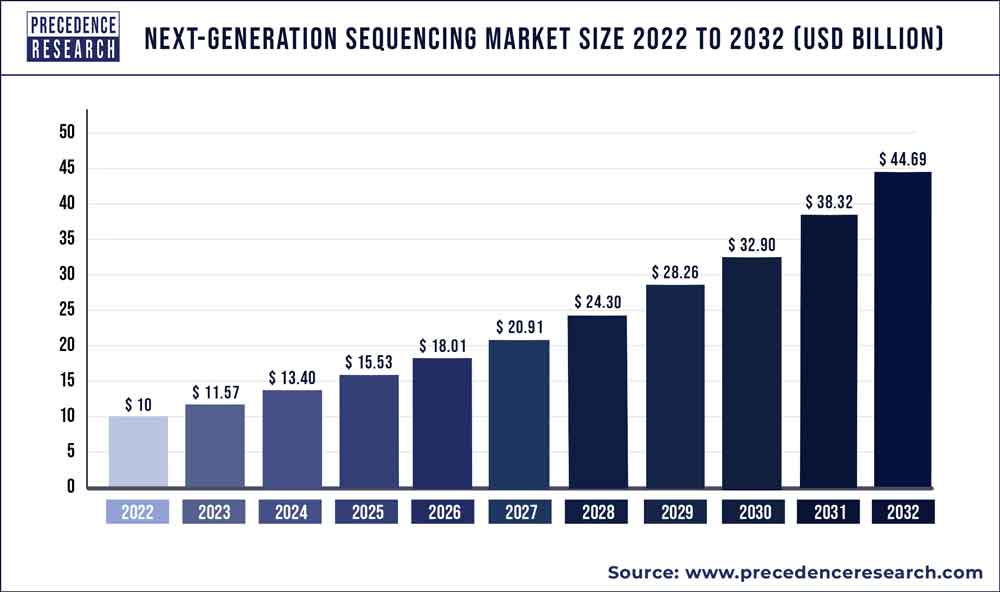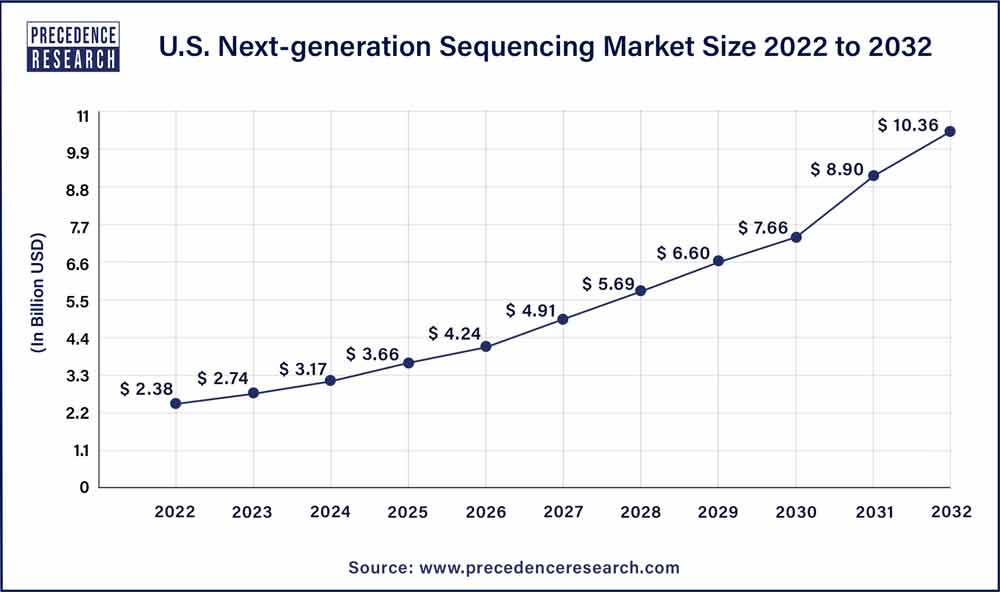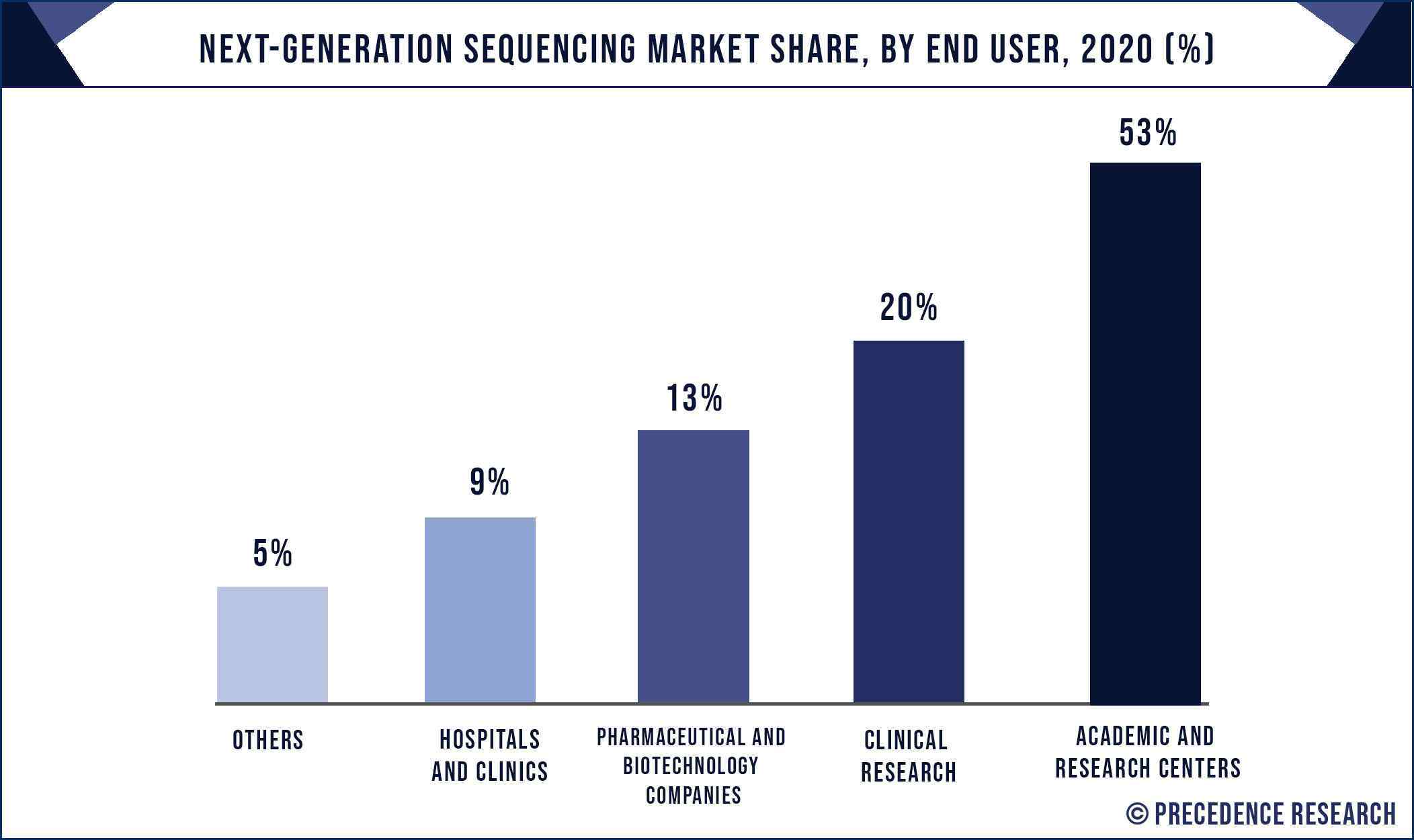September 2023
Next-generation Sequencing Market (By Product: Consumables Platforms, Services, Blockers; By Application: Diagnostics, Biomarkers and Cancer, Reproductive Health, Personalized Medicine, Agriculture and Animal Research, Others; By Technology: Sequencing by Synthesis, Ion Semiconductor Sequencing, Sequencing by Ligation, Pyrosequencing, Single Molecule Real Time Sequencing, and Others; By End User) - Global Industry Analysis, Size, Share, Growth, Trends, Regional Outlook, and Forecast 2023 – 2032
The global next-generation sequencing market size was valued at USD 11.57 billion in 2023 and is expected to surpass around USD 44.69 billion by 2032, poised to grow at a remarkable CAGR of 16.20% from 2023 to 2032. the broad utility of next-generation sequencing in medicine, agriculture, ecology, and many other fields, as it is used in disease diagnosis, prognosis, and therapeutic decisions, is surging the market's growth.

The U.S. next-generation sequencing market was estimated at USD 2.74 billion in 2023 and is projected to expand around USD 10.36 billion by 2032, at a CAGR of 15.90% between 2023 to 2032.

Based on the region, the North America segment dominated the global next-generation sequencing market in 2022, in terms of revenue and is estimated to sustain its dominance during the forecast period. The direct presence of key manufacturers, the active government support, and the rising cancer prevalence are the primary drivers of the market expansion in North America throughout the forecast period.
Next-generation Sequencing Market Revenue Share (%), by Geography, Global, 2022
On the other hand, the Europe is estimated to be the most opportunistic segment during the forecast period. Due to increased research expenditure, a focus on precision pharmaceuticals, and strategic alliances, the next-generation sequencing (NGS) market in Europe is expected to grow.
Next-generation sequencing comprises DNA and RNA sequencing technology which has the ability to rapidly analyze large amounts of genetic material. It holds the potential to sequence hundreds and thousands of genes or whole genomes in a limited duration. The commercial use of NGS was initially known as massively parallel sequencing. The advantages that come along with NGS are lower sample input requirement, higher accuracy, and the ability to detect variants at lower allele frequencies compared to the traditional Sanger sequencing by capillary electrophoresis (CE). Next-generation sequencing technology is transforming the biological science field by allowing laboratories to perform a wide variety of applications and study biological systems at an advanced level.
Building new genome: Researchers use de novo sequencing with assembly for the development of new genomes from unknown organisms. Assemblers are tools that put together the fragmented reads on DNA by aligning regions with overlap to build a genome sequence.
Measurement of genetic variation: this is achieved from an organism with an existing reference genome. When the reference genomes are compared with sequencing results, researchers get the genetic variation such as single nucleotide polymorphisms (SNPs), structural variation, copy number variation and others using software programs.
NGS technologies: the advanced technologies allow microbial ecology scientists to investigate genetic material from environmental samples on a large scale. With this, scientists are able to extract DNA from the environment without cloning.
Integration of artificial intelligence and machine learning in next-generation sequencing has the potential to transform the biotechnology industry. It offers more valuable insights on genomic research and opens new opportunities. An analysis of a large amount of generated next-generation sequencing data is time-consuming and complex. AI and ML algorithms have the ability to automate and optimize NGS data analysis, making the process more accurate and efficient. The primary application of AI and ML in NGS is noted for aligning sequences to a reference genome.
| Report Coverage | Details |
| Market Size In 2023 | USD 11.57 Billion |
| Growth Rate | CAGR of 16.20% |
| Largest Market | North America |
| Fastest Growing Market | Asia Pacific |
| Base Year | 2022 |
| Forecast Period | 2023 to 2032 |
| Segments Covered | Product, Application, Technology, Region |
| Companies Mentioned | BGI Group, F. Hoffmann-La Roche AG, Pacific Biosciences of California Inc., Thermo Fisher Scientific Inc., Agilent Technologies Inc., Precigen Inc., Illumina Inc., Qiagen N.V., PerkinElmer Inc., PierianDx Inc. |
Driver
Precision medicine
Rising demand for precision medicine is observed to be increasing significantly with the advancement in next-generation sequencing (NGS) technology which rapidly sequences large parts of an individual’s genome to help create precision medicine. It is a medicine in a healthcare model that uses genomic data to design treatments for a person, instead of using a “one-size-all” approach. NGS in precision medicine allows for rapid and accurate sequencing of a tremendous number of genes at once. Researchers at the Next Generation Precision Medicine Program have developed a Childhood Cancer Model Atlas (CCMA), which is the world’s largest single-site collection of high-risk paediatric cancer cells. Precision medicine is proven to be beneficial in oncology to deliver the right cancer treatment to a particular patient with the right dose at the right time.
Inaccurate data quality and interpretation
When a massive amount of data is been analysed, there is a chance of quality discrepancy. The next generation sequencing data can be affected by various sources such as sequencing errors, sample contamination PCR bias, and alignment errors. These errors could lead to false positive results, false negatives or misinterpretation of the results. This problem can be mitigated by the development and implementation of robust methods and standards for data quality assessment, error correction and variant calling.
Research and application
Next-generation sequencing market future is expected to expand immersive in terms of evolving and improvement, offering new opportunities in the field of biotechnology and advanced research and application. Single-cell sequencing is a new and impactful technique that allows the analysis of individual cells instead of a bulk population. Long-read sequencing is an emerging technique involving a generation of longer reads, ranging from hundreds to thousands of base pairs. In comparison with should read of NGS which has less than 300 base pairs. This technique offers more information on the haplotype, phase, and context of the variants. Along with that, long-read sequencing can be performed by various platforms, such as nanopore, PacBio, and 10x Genomics. In situ sequencing is a modern technique used to perform sequencing directly in the tissue or cell, without any extraction, amplification, or library preparation. In situ sequencing can also enable the simultaneous detection and visualization of multiple types of molecules.
The platform segment is projected to witness the fastest growth during the forecast period. The growth of this segment is expected to witness as it allows researchers to sequence everything from specific targeted regions to the entire human genome in a single day with the help of millions of DNA fragments in parallel. Choosing the right NSG platform for every laboratory develops on the method, software needed and technology and support. Considering all this, it should benefit from application flexibility, expert-level technical support and a global community of scientists and researchers.
The oncology segment contributed the largest market share in 2023. The dominance of this segment is noticed as it facilitates genetic diagnostic techniques which offer analysis of multiple genes in tumours simultaneously to help identify specific mutations and understand cancer treatment. In some cases, the patients’ blood test sample is taken is a small amount of tumour DNA that may be shed from the cancer. NGS is employed to identical new and rare cancer mutations, detect familial cancer mutation carriers and provide a molecular rationale for targeted therapy. NSG has been adopted in clinical oncology for the development of advanced personalized treatment of cancer.
The consumer genomics segment is anticipated to register a significant CAGR during the forecast period. The expansion of this segment is noted as the next generation sequencing technology is used in consumer genomics to provide insights into an individual’s genome. The consumer genomics is significantly expected to grow due to the increase in advertising spending from key players, and a decrease in genotyping and sequencing costs. Additionally, more companies are expected to enter the direct-to-consumer market in genomics.
The academic research segment dominated the surgical snare market in 2023. The dominance of this segment is observed as next-generation sequencing is a robust platform in academic research allowing researchers to analyse genetic material quickly. The university and community benefit factor contributes to providing significant growth to the market as the increasing acceptance towards scientific research, scholarship supports universities. Additionally, it offers the exploration of laws and theories that ring a better understanding of social phenomena towards NGS.

The clinical research segment is observed to grow rapidly in the surgical snare market during the forecast period. The expansion of this segment is expected as it plays a crucial part in the development of novel treatments, medications, and tools to prevent and treat any disease. clinical research in NSG uses sequence DNA and RNA, and detect genetic variants and mutations. On a clinical level, next-generation sequencing helps in the identification of rare and new cancer mutations, detects carriers of similar cancer mutations, and provides the molecular basis of particular therapies.
In July 2024, Thermo Fisher Scientific, the world leader in serving science, is partnering with the National Cancer Institute, helps to accelerate research into a new treatment for Acute Myeloid Leukaemia and Myelodysplastic Syndrome on clinical research and treatment utilizing next-generation sequencing technology.
The whole genome sequencing (WGS) segment is observed to grow rapidly in the next generation sequencing market during the forecast period. WSG stands for whole genome sequencing which has a specific application of next-generation sequencing. The expansion of this segment is expected as it offers the most comprehensive data about the given organism. This also offers novel genome assembly, it provides a high-resolution view of the complete genome including coding and non-coding regions. WSG is widely applicable in cancer research, genetic disease research, epidemiology, and genotyping.
The sequencing segment held the largest share of the next generation sequencing market in 2023. Sequencing by synthesis (SBS) chemistry is used to detect single bases as they are incorporated into growing DNA strands. Plenty of sequencing frameworks are available to support the extensive spectrum of throughputs and applications. Most sequencing instruments use optical detection to determine nucleotide incorporation during DNA synthesis.
The NGS Data Analysis segment is observed to expand rapidly in the next generation sequencing market during the forecast period. The growth of this segment is noticed due to the growing acceptance of sequencing systems for clinical diagnosis reason behind its hefty cost reduction of installation. Additionally, the availability of easy genomic and proteomic information is expected to generate a significant growth opportunity in the industry in the coming future.
In October 2024, Jacob Thaysen, CEO of Illumina said, “Our customers told us they need a faster, smaller, and easy-to-use instrument, and that’s what we’re delivering with the MiSeq i100.”
Key Companies & Market Share Insights
The next-generation sequencing market is characterized by fierce competition among the key market players. The launch of novel platforms that are fast, small, and less expensive is one of the strategies used by the companies to improve their market position. Cerba Research, for example, announced two new COVID-19 exploratory tools in January 2021, one PCR-based and the NGS-based to enhance research and development for vaccine development against coronavirus.
Segments Covered in the Report
By Product
By Application
By Technology
By Workflow
By End-use
By Geography
For inquiries regarding discounts, bulk purchases, or customization requests, please contact us at sales@precedenceresearch.com
No cookie-cutter, only authentic analysis – take the 1st step to become a Precedence Research client
September 2023
October 2024
February 2025
February 2025